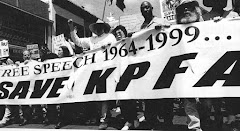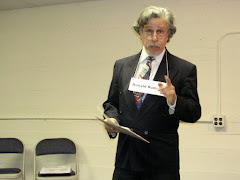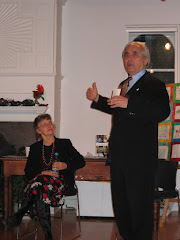 General Manager Duane Bradley was on the air pitching when I arrived at KPFT in Houston. Pacifica Radio’s Texas station was in the midst of its Winter 2006 fund drive and about a half dozen volunteers were fielding calls in the first floor meeting room as Duane paced, touting the unique and vital role of Pacifica and its Houston outlet. The building was a converted home in a residential neighborhood, a bit too small to meet the station’s needs and yet somehow comfortable. It felt like I was joining an extended family in the middle of a major project.
General Manager Duane Bradley was on the air pitching when I arrived at KPFT in Houston. Pacifica Radio’s Texas station was in the midst of its Winter 2006 fund drive and about a half dozen volunteers were fielding calls in the first floor meeting room as Duane paced, touting the unique and vital role of Pacifica and its Houston outlet. The building was a converted home in a residential neighborhood, a bit too small to meet the station’s needs and yet somehow comfortable. It felt like I was joining an extended family in the middle of a major project. Over the weekend I’d driven across the south, stopping along the way to talk with Ginny Welsch, the driving force behind affiliate station WRFN-LP, also known as Radio Free Nashville. One of many low-power stations launched in recent years, it had signed on just nine months earlier. Like many community-based stations, its core mission was to be “a voice for the voiceless,” she said.
WRFN carried Democracy Now! and Free Speech Radio News as part of a mix that was 60 percent talk and 40 percent music, mainly produced by about 100 locals. Ginny’s current focus was to get high school kids involved in developing shows, a priority that expressed her commitment to diversity. What she needed from Pacifica, beyond access to its wealth of programs from around the country, was training in newsgathering and editing, along with advice on how to produce programs that other stations might want to air.
The meeting was encouraging, since it suggested that Pacifica remained a source of inspiration and potential resources for emerging stations. Low power radio didn’t reach huge audiences but stations could be launched with limited money in smaller communities. They represented a promising way to expand the network’s reach.
KPFT was considerably larger, a 36-year old full-power station with a strong signal that reached far beyond the boundaries of the sprawling Texas city, beaming talk and music to multi-ethnic communities along the Gulf Coast. After recovering from two KKK-backed bomb attacks on its transmitter back in 1970, it went on to become the first public radio station to broadcast programs in 11 different languages. For a while it had one of the most eclectic FM formats in the country.
Duane Bradley was briefly the station’s program director in the late 1980s, and subsequently joined KPFT’s local advisory board. But the dominant personality throughout the 1990s was Garland Ganter, who started as news director, then became program director, and was appointed general manager in 1994 – just as the struggle over the long-term direction of the network began. As station manager and later national programming director, Ganter supervised a format conversion that replaced so-called “radical” programming with music and more inoffensive fare. As at KPFK and KPFA, shows with an overtly leftist perspective were dropped, along with those in foreign languages or geared to specific ethnic communities. It was all part of a national plan to “mainstream” Pacifica in hopes of attracting a broader audience. Grassroots activists considered it an unconscionable sellout.
In 2002, Ganter resigned and Bradley returned, this time as general manager of KPFT. Otis Maclay, a long time producer and radio personality at both KPFT and WBAI, was hired as program director, and the “Texas Jukebox” format was gradually replaced with more traditional Pacifica programming. But after a promising spike in audience during the first year of the Iraq war, Arbitron ratings recorded a 25 percent drop in listenership in 2004. The following year was only marginally better. Overall, Pacifica was losing ground, but the trend was especially noticeable at the Houston station.
With both audience and financial stability at risk, Duane decided that something had to be done. Local activists and a majority of the station board wanted a mission-driven morning drive time schedule with Democracy Now! At 7 a.m. Maclay supported that position and the change was made. However, he was soon transferred to a newly created consulting role as national technical director and replaced locally by Ernesto Aguilar.
Despite some promising signs and a visit to Houston by Amy Goodman, DN’s early morning spot on the schedule lasted little more than a month. Although it was still aired weekdays at 9 a.m. and re-broadcast in the evening, most of the morning public affairs shows were replaced by music and lighter talk. Flashpoints, a controversial program out of KPFA that often focuses on the Israeli-Palestinian conflict, was moved from 7 p.m to 11. Public affairs remained in the mix to a greater extent than at WPFW, but the emphasis had shifted.
The strategy appeared to work. The station showed modestly improving audience and financial numbers. But some of the activist community felt abandoned and betrayed. Upon joining the national board – just as I became Executive Director – KPFT delegate Ken Freeland presented me with his bill of particulars.
In a widely-distributed critique Ken wrote that “current management has demonstrated that they are not fit stewards of our airwaves. If management were embezzling money belonging to the station, few of us would sit back and not demand action. But management is doing something that is morally not much different, it is playing Robin Hood in reverse, stealing prime airtime from KPFT’s best programming, our world and national news and information programming, and lavishing it on select local programmers, whose programs do not answer to this indispensablepart of Pacifica’s mission. The backwards march of our program lineup over the past year or two is unconscionable.”
I couldn’t help sympathizing, at least somewhat. But it was a difficult balancing act – keeping the station solvent and growing while considering the demands of diverse, not always compatible constituencies. In addition, I had hit it off early with Duane, who avoided the type of angry, defensive rhetoric I heard in some quarters. Listening to him tout the importance of Pacifica during on-air pitches with Amy Goodman I sensed that he understood the stakes, though he might be playing it a bit safe. Ken, in contrast, was adamant, judgmental, and trapped in the typical Pacifica dynamic of conflict and blame.
Part Five of Pacifica Radio: A Listening Tour
Next: Pacifica Radio: Network or Movement?
































No comments:
Post a Comment